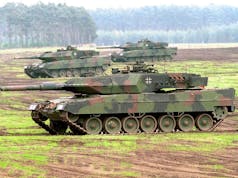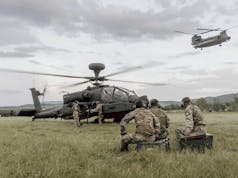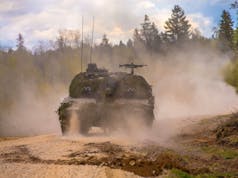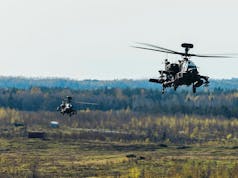BAE Systems 155mm ARCHER wheeled howitzer system successfully completed testing during the U.S. Army’s ‘shoot-off’ evaluation, say the firm.
The service is evaluating whether to add a wheeled capability to its arsenal.
BAE say:
“ARCHER is a fully automated mobile weapon system that provides highly responsive and versatile fire support to troops in combat.ARCHER fired about 450 rounds, including six to 12 round bursts, and up to as many as eight rounds per minute, during various testing in different conditions at the Yuma Proving Ground in Yuma, Ariz. over the summer evaluation.
The shoot-off included charge compatibility with Army rounds, soldier training and testing, mobility, performance of Army’s identified requirements, studying integrated digital fire control, and maintenance evaluation.”
Mark Signorelli, vice president of business development at BAE Systems, was quoted as saying:
“We are confident ARCHER meets the need for new wheeled artillery system with unprecedented shoot and scoot capability so soldiers can avoid counterfire,” said Mark Signorelli, vice president of business development at BAE Systems. “We look forward to additional opportunities to demonstrate the full breadth of ARCHER’s capabilities to the Army.”
ARCHER can initiate fire within 30 seconds of receiving an order and depart in the same amount of time and in service with the Swedish Army.
The testing at temperatures reaching 50 degrees Celsius in Arizona demonstrated ARCHER can operate effectively in high temperatures as well as in arctic conditions typically experienced in northern Sweden.
“Soldiers can operate and fire ARCHER while remaining in the armoured cabin through its fully automated fire and ammunition loading system. Its magazine carries 21 rounds and can fire all of them in less than three minutes. ARCHER can fire the precision BONUS anti-armour munition up to 35 km, conventional munitions up to 40 km, and currently fielded precision-guided munitions like Excalibur in excess of 50 km. BONUS and Excalibur are currently in the U.S. Army’s inventory.”













Best there is I should think. Swedes make awesome kit when they set their minds to it
Does BAE design and make this in Sweden then?
Yes. It’s designed and made by Bofors which is now owned by BAE
Bofors have also developed the Excalibur and the Bonus artillery shell.
Always funny how those who generally keep their heads down when it comes to a fight are actually fantastic at making the weapons for those that don’t and make the ultimate sacrifice.
Its the ‘porcupine’ strategy.
Remember Sweden was once one of the major powers in Europe reaching its influence far and wide and eventually into the conquest of Poland and against whom (and indirectly as a result of that expansion) Peter became Great and Russia grew in strength. Thereafter as other powers started to outstrip it through shear numbers they were sensible enough to take on the state of neutrality reducing its threat to those strong neighbours while retaining a defensive posture strong enough to deter them should they ignore that neutrality making it not worth doing so. It has served them well and ensured their independence since I would say. Bae is certainly doing very well out of its investment in them that’s for sure. Long may it continue as we seem to have surrendered UK design and manufacture of such impressive technology.
Great points Spy. I must say I agree totally with your conclusion about the UK giving up its design and manufacture of such things. I just wish UK Gov would do something about it.
If WWII was anything to go by, I wonder where half the Irish and Switzerland will be when the next hairy-arsed psychopathic dictator makes a grab for world domination… or where Germany will be for that matter.
Who generally keep their heads down? Look at Sweish soldiers track record in the Winter war, Bosnia, Afghanistan, Congo. Try meeting a swedish mechanised brigade with Leopard 2 A5 and CV90 – you would get some heavy bashing.
https://thestrategybridge.org/the-bridge/2017/9/20/trigger-happy-autonomous-and-disobedient-nordbat-2-and-mission-command-in-bosnia
http://www.svenskafrivilliga.com/sfk3.html
I agree.
Mainly because they a good at small teams and don’t over complicate things.
So it will work and be easily serviceable.
In the UK we go down the perfection/Swiss Army Knife rabbit hole(s).
agreed we could take a spade and what it to turn into a hang glider
just beacuse
Indeed which sadly rarely actually lived up to the expectations inherent in such gold standard pretentious. Get the worst of both worlds too often over cost under spec and late meaning few exports too low and short a home production run and inevitably as a result loss of manufacturers and those that remain less capability to move on to design and build their replacements and increasing mediocrity at higher cost as a result so the ability to even design to that bold standard no longer exists. Bit like British industry generally I guess.
Question for those in the know. What are the plus and minuses of wheeled and tracked howitzers for our army? Do we ideally need both for different environments? I keep looking at the Archer and wondering how that would fit into a mechanized brigade.
Not an expert, but, a former Warsaw pact artillery colonel who transferred to the Slovak Army asked me why we did tracked arty – now WP / Sovs were big on arty – generally cheaper and more reliable to go wheeled was their consensus albeit they did have some tracked pieces.
I’m not sure what he meant exactly because the Soviet Union and now Russia designed and built large numbers of tracked self-propelled artillery, designed to keep up with their armoured and motor-rifle divisions. Perhaps the Czechslovak army was a bit different, being expected to fight in more mountainous terrain?
The Warsaw pact had “some tracked pieces” ? That must have been a bit of Warsaw Pact humour that got lost in translation 🙂
No, they had shoite loads of everything I remember was it a Regt of their arty against a battery of ours and theirs could fire further… all I had to do was dig a hole and wait until I got buried… fun times 🙂
its more to do with terrain, and generally a tracked system was or used to be more robust, if you take how easy a Saracen used to lunch its gearboxes, computer-controlled gearboxes and transmissions open a larger envelope
There are other factors too. A tracked SP gun provides protection for the crew, weapon system and ready rounds.
Opinion of a lifelong civilian with an engineer’s interest in military technology:
I believe a lot of it comes down to strategic vs tactical mobility: wheeled equipment can self-deploy further, more quickly, more cheaply, with less support, than a tracked equivalent (strategic mobility win to wheels); tracks give lower ground pressure and better traction, so your artillery can deploy to more inaccessible areas- giving wider options to a commander for concealing/protecting the vehicles and also potentially to deliver effect in areas the enemy may not be expecting (tactical mobility win to tracks).
In addition, tracked vehicles are often also more heavily armoured- giving better protection to the crew in the even of counter battery fire and stuff like that.
On the flip side, wheeled systems are cheaper to buy, easier and cheaper to maintain (especially if that wheeled chassis is common to other vehicles in the fleet), and require fewer specialists to operate the non-shooting bit.
It comes down to a bit of a tie, depending on what the mission is and the personal opinion of the person involved. For my money, for the UK, I’d go wheeled. For the US, with the resources they have, I’d get both.
Agree. Tracked vehicles are much more expensive to maintain. Typically require wheeled transporters to move them into theatre of operations. Whereas a wheeled artillery unit can self deploy.
Definitely think we should replace AS90 with the Archer system.
I’ve not looked into all of the competitors, so not sure I have a preference beyond a wheeled 155 mm system with a greater barrel length than the AS90 (assuming that means greater range). But I’ll take your recommendation for Archer, the Swedes make good gear and it pays to keep them sweet with the Tempest project.
My gut feeling (though I have no military expertise to back it up) is that a wheeled solution would be best overall for defensive application while tracked would be better for offensive strategy. While in an ideal world you would still adopt lesser numbers of the other type to fill specialist roles in support of those two fundamental opposing strategic priorities for instance the need for counter attacks even in a defensive scenario. So taking the expected UK/NATO role in any major European conflict ie primarily defensive, wheeled would seem to me to be the better solution generally even if you would prefer both options.
I am thinking the ability to fire remarkably accurately with smart ammunition over long distances must ameliorate some of the obvious historical tracked vehicles advantages in regions where roads and/or reasonably good off road terrain is less common. The balance has I’m sure moved towards wheeled substantially these past decades as a result of how Europe itself has changed as an environment.
It’s potentially worth bearing in mind the experience of the Armenians recently too: Azeri drones were all over the battlefield, providing ISR and targetting data to loitering munitions and even making strikes themselves. I’m frankly not sure that the extra armour and ability to go more off-road is as much of a benefit as it used to be.
We still need to deploy the tanks and Ajax by tank transporters.
Joe, you have pretty much covered all the angles. We have in recent years had a mix of tracked SP guns (Abbot, then AS90) and towed guns (105mm light gun and its predecessors), plus of course rocket artillery (GMLRS) which is tracked.
There isn’t much British artillery (the arm comprised 25% of the army in WW2, but 9% today – but I accept that lethality and accuracy improvements have compensated to some extent) and it is all dated. Many countries have retained but upgraded towed artillery to 155mm – amazing that BAE produce(d) a superb 155 towed gun, which we still have not bought.
What muddies the waters is that we will drop Warrior in time, replacing it with an additional buy of Boxers, so HBCTs will have a mix of tracked (CR2/3) and wheeled (Boxer) key assets. If that works then there will be acceptance of a wheeled truck-mounted artillery piece.
I understand that AS90 is to be replaced in 2030/32 by the Mobile Fires Programme equipment but it might not have to be tracked.
So who knows?
Or would we be better off sticking with Rheinmetall’s next-gen HX3 tactical trucks?
Rheinmetall MAN Military Vehicles HX3
https://www.janes.com/defence-news/news-detail/rheinmetall-unveils-hx3-truck
One for the experts to debate!
https://rheinmetall-defence.com/en/rheinmetall_defence/systems_and_products/vehicle_systems/military_trucks/hx3_generation/index.php
It will be an interesting competition. I think Rheinmetall was too late to the party for the US competition. The UK offering is based on the same MAN chassis I believe so if mobility was the same I guess it comes down to initial cost, maintenance and reliability.
That’s RM gun truck looks mean…
Would there be a consideration for a mixed wheeled and tracked artillery fleet?
If a low cost UAV can take out an MBT, how effective is the shoot and scoot capability of a platform like this? It might make sense in the forests of Sweden, ( a bit like the S tank did) but in open terrain, will it not be an easy target for a modern missile like Brimstone?
Isn’t the real power of artillery the ability to deliver heavy and sustained fire? That can still be achieved at lower cost by towed guns. The primary need for mobile artillery is to keep pace with armoured formations so tracked vehicles are preferable.
Low cost is a relative term, you still need something the cost of a reaper to carry the size of missile required to take out a tank and the missiles are not exactly cheap. These larger UAV in turn are fairly slow and can be shot down by equally cheap anti air firepower, think ww2 style guns with some modern sights etc. Warfare is always going to be a combined arms style, with each capability being nullified by another, with who ever has the right platforms in the right place, in right numbers winning.
Main challenge for the UK and kinda NATO in general, is the lack of ground based air defence. The reliance has always been on having air coverage, which can’t really be guaranteed, in the numbers required, when it comes to cheaper drones.
Hence why using radar guided 30/40mm AA cannon is a thing again in the battlefield.
It isn’t hard to deny the battle space to cheapo UAV’s.
Point taken about UAVs- as you say, air defence ought to be able to counter them.( Resurrect the SABA concept?) I was questioning the benefits of the shoot and scoot ability. Archer and Caesar do seem capable of getting in and out of action quickly. But some towed artillery is quite rapid.
Wheeled platforms seem to be in favour at the moment and I understand their advantage of easier deployability at distance. But these heavy wheeled SPGs need to be accompanied by another large vehicle to carry reloads. To me , they seem a clumsy compromise between well armoured tracked SPGs and towed artillery.
The main benefit of wheeled artillery is the speed in which it can setup and fire. Yes, wheeled will be tracks on roads and hardened surfaces, which is great for mobility. But that’s not the primary benefit. The Archer system using the Volvo truck can set up and fire in around 30 seconds, bang off 8 rounds in a minute, then retract the stabilizers, then bugger off to the next firing point, again in around 30 seconds.
For a towed piece, it will be a lot slower, as it is heavily reliant on the number of personnel you have available, to not only unhitch, then set up the piece so that its level, then feed it the shells and propellent. When you get the order to move again, it will rely on your personnel to stow the piece properly, then re-hitch it to the wagon, before they can drive off!
In the time it takes one shell to reach its apogee, a “fires” detection radar will have tracked the shell, and then plotted the approximate firing point. This info will be relayed to a counter battery team, who then fire on the plotted location. Again this will take a bit of time, but if a team is ready and waiting on the call, they can be shooting at the location in less than 5 minutes. This means its vitally important to be able fire as fast as possible, whilst remaining accurate, but also be able to move at a moments notice, before the counter battery fire reaches you.
To be brutally honest, towed artillery has had its day. The ability to shoot and scoot is the only way artillery will be able to live and fight on, in a peer vs peer conflict. Especially now that UAVs have narrowed the window between detection time and the counter battery time.
The Archer in particular has a fully automatic loading system. It will even unload a loaded charge and shell. The support vehicle that’s used to resupply the Archer is semi-automatic and needs a crew to service the resupply. This can be down in just under 8 minutes from an empty magazine.
Oher systems out there like the Caesar are less automated and still require a crew to service the piece.
I’ve seen the promotional videos and Archer can indeed change position quickly. But a towed system like LIMAWS isn’t slow. Neither is as quick into action as a tracked vehicle.
There are some advantages to towed artillery- guns can be located in positions that SPGs can’t reach (helicopter delivery or even manhandled) or sited in protected positions. One of the great strengths of artillery is the delivery of continuous fire over long periods. Whilst the high mobility of Archer type systems looks fine when a handful of vehicles is involved, I can’t see them working effectively in large numbers,, each firing a salvo and the relocating repeatedly.
I remember LIMAWS. I admit that the new BAe M777 is a decent weapon system, but it still needs a crew of 7 to service it. It is still a beast even though a lot of parts are made from titanium to drop the weight. It would have made a decent replacement for our FH70s, as it weighs about half. However, both are calibre L39 guns, so their range on basic ammo is the same at 24km. Both used the standard NATO regulated breech chamber, so both could use the same assisted and guided ammunition.
According to the blurb, it takes over 6 minutes to set up and the same again to recover. On a number of occasions in Afghan I called on these (Australian, Canadian and USMC) for fire support missions amongst other artillery available to me, such as our smaller 105s and US MLRS. Where the gun has a fixed firing point and is not in risk of counter battery fire. The towed gun still has its place.
But when faced with a peer, not so much. The example I have is from Ukraine. This is where the “Russian” separatists located a Ukrainian field battery of 8 x 122mm guns, through radar and back plotted their firing point. The Separatists then used 4 x BM30 Smerch to obliterate the grid square. Some of the gunners saw the rocket plumes arcing up into the sky and made a run for, there were many who didn’t make it!
The Ukrainians did not have a counter-battery radar or a SAM system closeby, so they had to rely on a visual warning. Which meant they stood little chance against a peer opponent, who was ready and waiting for a counter-battery duel.
This is where a vehicle based Archer system gives you a better chance of completing your mission and surviving. I don’t know the timings between the detection of the Ukrainian battery and the counter-battery return. But either the battery commander didn’t realise what he was doing or was just naive on the Separatists capabilities. However, they paid the penalty of not quickly relocating following a fire mission.
The Archer system can be networked together through a radio data-link. This means the vehicles can be further spaced apart but still coordinate their fire mision on a given target. This will on its own make it harder for counter battery fire, as they will have to widen the splash area to have a chance of a hit. It is also crucial that the units are linked to a counter battery detection radar, like our mobile artillery monitoring battlefield radar (MAMBA) to give plenty of warning on return fire.
Towed artillery seems to retain utility for light role brigades, such as 3 Cdo Bde and 16 AA Bde. ARCHER or CAESAR would surely be too big, heavy and expensive for such formations.
I don’t deny truck-mounted artillery is good for heavier formations.
In Afghan, we used the 105 L118 gun from a Chinook, in a shoot and scoot role. The Chinny would land on a hill, the gun rolled down the ramp, set up, bang off a few rounds then get winched back up the ramp. Where the Chinny would take-off and fly to the next location and repeat.
It worked quite well for one gun, but doing it for more than one would mean the Chinooks couldn’t be used for anything else. I think it worked ok in Afghan, because there was no missile threat to the Chinook. Not sure it would have worked so well against someone with a decent air defence network?
The L118 is significantly faster to set up and operate when compared to the Russian D30. Which for the shoot and scoot role is vitally important for light forces. What has been of interest is that DSTl have produced an image of a future semi/autonomous vehicle concept, mounting a field gun with an autoloader.
https://pbs.twimg.com/media/E5S62QBX0AE3SMJ?format=jpg&name=900×900
Could this be the future of gun artillery for the light and rapid reaction forces?
This could be the answer going forward?
BAE Systems has demonstrated its AGR-20A Advanced Precision Kill Weapon System II (APKWS II) 70mm/2.75 inch laser-guided rocket system in a surface-to-air counter-unmanned aircraft system (CUAS) role.
https://www.janes.com/defence-news/weapons-headlines/latest/bae-systems-demos-apkws-ii-in-cuas-role
I don’t get your point Peter. Shoot and scoot is to deny the enemy the chance to launch effective counter-battery fire. Why would you not want to be able to do that?
Has Geely divested itself of Volvo? I can’t see the US opting for this with a Volvo truck chassis (however good it is) if it’s from a partly Chinese-owned company. Perhaps they’re testing the MAN truck version?
I believe AB Volvo trucks and Volvo cars are not the same company Geely wholly own Volvo cars but is only a stakeholder in AB Volvo. But I don wonder how long the status quo can continue with these Chinese companies the Chinese state is asking large companies to contribute billions to the state under the its ‘common prosperity’ policy or are getting huge fines for various ‘irregularities’. Effective European consumers will be further funding the Chinese state.
In that case it looks like a strong contender. With regards to your other point… it’s also forcing them to hand over their technology to the state / military.
That is my understanding, similar to Rolls Royce and Rolls Royce 🙂
Ford bought the Volvo car division off AB Volvo in 1999, they had no interest in Volvo Trucks. Geely subsequently bought the car division in 2006 off Ford. AB Volvo have a 45% share in a Chinese truck maker and in 2017 Geely bought just under 9% of AB Volvo. Ownership in the automotive industry can be complex, where this affects the US military we wait to see.
some interesting new kit on the drawing board.
MBDA presents new concept of mobile tank destroyer equipped with Brimstone missiles
MBDA showcases Brimstone application on Milrem Robotics’ unmanned ground vehicle
That’s an interesting idea Nigel, imagine one that could ground launch Spear 3, that would be a seriously capable piece of kit!
Even with Brimstone, imagine six of these trundling about in the rear area of operations in forested areas of Estonia etc, ready to unleash 36 Brimstone missiles, that’s enough to seriously damage an enemy armoured Brigade all by themselves….
Exactly, this is the best way forward for us given the lack of boots on the ground as it were. A real game-changer!
The phrase that popped into my head on seeing the image was “Force Multiplier”
Very much so!
A bit like CVR(T) STRIKER? A 50mph vehicle with 5 Swingfire and 5 more inside, missile range of 4km. Scrapped without replacement by 2005.
We clearly need to up our game in this area and Spear 3 mounted on vehicles like the ones above would give us a clear advantage on the future battlefield.
Due in the mid 20’s, it would make sense to start planning for something like this now.
“Air Show 2012 as a “mini-cruise missile,” it featured “a new circular cross-section airframe (the same diameter as Brimstone), dorsally mounted flip-out wings (folding rearward for stowage), a revised intake arrangement with twin side inlets, and three folding tail surfaces in an inverted ‘Y’ configuration.”
https://missilethreat.csis.org/missile/spear-3/
I am a bit surprised that there hasn’t been a similar proposal for Spear 3? Longer ranged than Brimstone along with a loitering capability.
Fantastic pieces of kit. If u can get the targets for these drones to hit that’s great. Shoot and scoot will still have to apply to these as with anything that is in the battle field. Need to put some thoughts into what role the kit will fall into and what enemy will they be used against.
I’m sure someone more knowledgeable than me can come up with a suitable answer! But very interesting nonetheless.
Brimstone is a supersonic missile (Mach 1.4/450 m/s), which means it will take just over 1 minute to reach 30km from a ground launcher. Here’s the conundrum though. When we still had the FH70 155mm gun, it could fire a base bleed shell to just over 30km with a muzzle velocity of just over 800m/s. Which meant the shell hit the ground in around 37 seconds.
If we kept towed artillery, I’m certain we would have bought the M777. But also looked at the guided and autonomous shells like Excalibur and Bonus for it. However, neither of these have the ability that Brimstone brings to the table. Where Brimstone can have multiple uses against both moving vehicle and fixed targets without 3rd party help, but also adjust its attack profile to maximise its chance of successfully neutralising the target, i.e. adjust for top attack on a MBT for example. Brimstone uses an active millimetric wave (mmW) radar as its primary sensor. This produces near picture quality images of a target, but also allows it to see through camouflage and tree foliage. Thereby allowing it to find hidden targets and minimise the number of rounds fired at a suspect area to hit the target.
The obvious downside is the high cost per missile, which has a knock on affect on the number that are purchased. An artillery shell by comparison is significantly cheaper, so a larger stock can be purchased. As a precision fire ground launched weapon, Brimstone and Spear-3 could have their places in our inventory, where they are used against specific high value targets. Such as HQs, Communications, ELINT, counter-battery radar, and SAM systems. Brimstone still has its role to play against armour. Though it really requires a spotter to take advantage of its range. Furthermore, Spear-3 uses the same programable 2-stage warhead and radar as Brimstone, so it can also be used against heavy armour if required, but has the distinct advantage of being able to loiter of a suspect area.
This is the sort of thing I’m waiting for MoD to buy, not model aeroplanes.
Is this stuff just a concept or is it working and available?
I’m not sure Daniele but as DavyB mentions above Spear 3 on these would be a very nice bit of kit to have in our armoured brigades to make up the numbers!
At the 2019 DSEI, Milrem had a number of their Themis vehicles on their stand. There was one that was being used as a mule, one that had a remote weapon system mounting a GPMG, another with the Brimstone launcher on it as shown in the above image, provided by Nigel. The launcher and missile were model training rounds though. There was lots of interest on the stand, but I don’t think anything came of it, as Milrem, was still a pretty small unknown company.
What has changed though has been Estonia’s military successfully using the vehicles in Mali. They had a few initial teething issues, but they were sorted pretty quick. When the Estonians were using it with the infantry on patrols, the vehicle was put into a “follow me” mode, where the operator walked ahead and the UGV followed him. They used it for carrying bergens and ammunition, plus it was used for casualty evacuation. One of the tests they did do with it was to load one on a RAF Mk5 Chinook.
https://www.army-technology.com/wp-content/uploads/sites/3/2019/10/20190923214657-0a51c8a0-me-e1569921613692.jpg
I think its only a matter of time, before we actually start to see something like the Themis attached to the infantry, especially when used as a mule.
And a possible control vehicle has just been shown for control of autonomous platforms like the one I mentioned?
“Rheinmetall announced in a press release on 14 October that it has developed a high-roof version of the Fuchs (Fox) 6×6 armoured transport vehicle for roles such as armoured ambulances and tactical operations centres.”
https://www.janes.com/defence-news/land-forces/latest/rheinmetall-presents-high-roof-version-of-fuchs-armoured-vehicle
These concept platforms have been around for a while now but so far no actual customers, which makes me think that maybe the tech isn’t quiet there just yet and/or its just not cost effective.
At the same time the Russians, among other potential adversaries, are developing their short range SAMs and 57mm guns to counter such weapons. As far as I can see, the Israelis are currently providing a real world test environment for the RuAF in Syria, with their regular F-16 attacks using what are thought to be their.Delilah missile.
Is this likely to replace the 155mm M777 towed howitzer, currently used by the US Army which, incidentally, is another BAE product?
Royal Artillery could do with a battery or three of these. Perhaps as a sweetener to appease BAE when placing the Ajax replacement CV90 order.